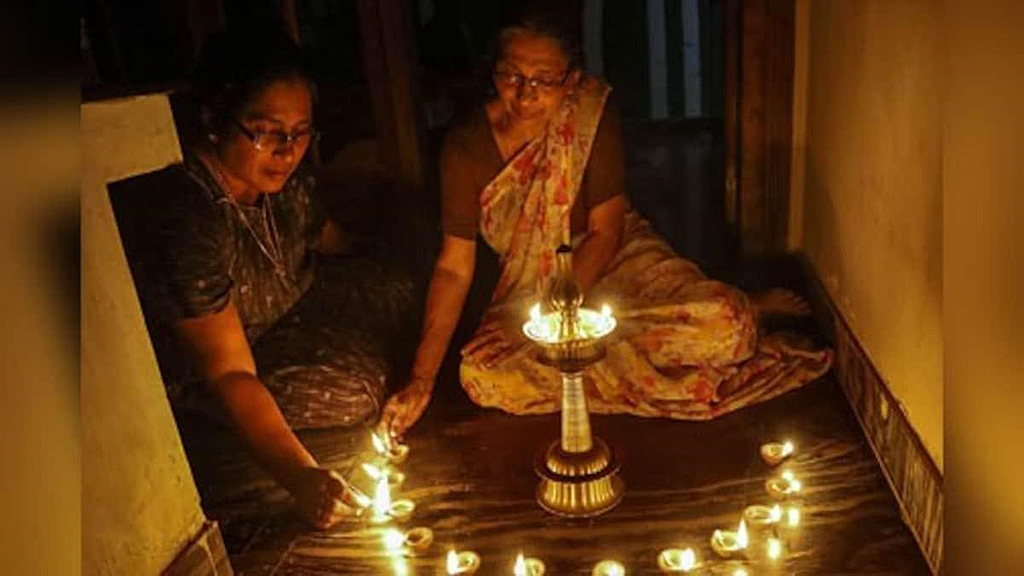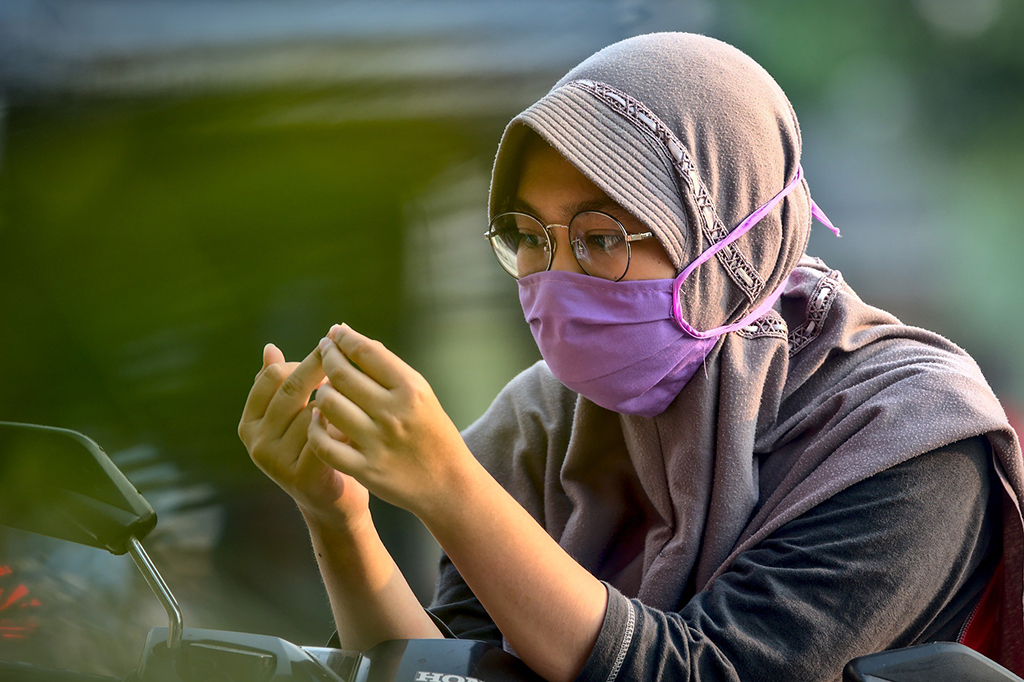Religious Response To The Pandemic Among Bengali Hindus In West Bengal: A Survey
contributed by Sreemoyee Paul, 19 November 2020

Cover Image: Corona and West Bengal
In this survey I look into the everyday religious performances of people belonging to various Bengali Hindu communities during the current global COVID-19 pandemic. In this situation where the world seeks healing on a large scale, I seek to infer the religious responses from members of these communities, if there has been any innovation in that regard and what has been its effect on the cultural fabric of the community. This report is based on what I observed around Kolkata on a daily basis, watched/read in various news channels or heard from people from the onset of the COVID-19 emergency.
POPULAR RELIGIOUS FESTIVALS
Preparations for the grandest festival of Bengali Hindus- the Durga Puja (pronounced pujo in Bangla) generally begin from the month of July with planning for the theme of the pujo pandals, to contacting sponsors, collecting chanda (donations from every individual staying at a neighbourhood of their respective pujo) and so on. Though centering on puja, the Durga pujo is regarded as a Utsav (festival) among Bengalis. However, this year, it was only puja without the Utsav. Hardly did people go for pandal hopping, and instead they visited each other’s family and celebrated the pujo mostly through adda. Scaling down of the Durga Puja has not only affected the income of idol makers, garment businessmen, but also many other side businesses which thrive on the seasonal economic stimulus of this large festival in Kolkata each year.

Fig. 1. Gathering of people for tarpan on the day of Mahalaya despite the pandemic (Source: Deccanherald)
However, even this year, on Mahalaya (this day marks the end of Pitripaksha (fortnight of forefathers) and the beginning of Devipaksha (fortnight of Devi)), hundreds gathered on the banks of the Ganga to offer their homage to their ancestors, disregarding recommendations for social distancing. Popular television programmes which feature myths concerning the Goddess Durga and her seven rup (incarnations) every year on Mahalaya, also included Goddess Bhramori in this year’s lineup - an incarnation of Durga who saves people from deadly diseases. Furthermore, this year there was a rare 35-day gap between Mahalaya and Shashthi (the day of Bodhon where the Goddess’ face is displayed to the public) according to the Ponjika (the Hindu astronomical almanac) because of a mall mash (unholy month) falling in between. It led to a joke among the Bengalis that Goddess Durga will quarantine herself before revealing her face keeping in mind the pandemic as she has come from outside the state of West Bengal (as per rules of the government for the common people).
The worship of the Goddess Bipodtarini (she saves people from bipod- danger), is usually a small homely affair. This year, however, it was quite extravagant. I even saw many people visit each other’s houses without wearing a mask - to which I wonder whether this was out of complete faith in the power of the Goddess to protect them from the disease.
There were also incidents highlighted by the media where on the day of Jamaishoshthi (the day the son-in-law seeks blessings from the parents-in-law and is in turn greeted by the in-laws with gifts and delicious dishes) there were gift transactions but no touching of feet (to show respect in India the feet of elders are touched to receive their blessings) of the mother-in-law by the son- in-law, in order to maintain physical distancing. Similarly, in a Shraddha ceremony (performed after the death of a person) of a relative of mine, the priest did not come, but instead recited the mantras over the phone and collected his dakshina (remuneration) through an online transaction, in order to avoid joining a crowd.
As seen in the examples above, the economic aspects of the ceremony were performed but details of the ritual action were altered. Similarly, this year pujo days were made flexible in order to accommodate the packed schedules of priests. For example, if the pujo was supposed to be conducted on Thursday, it was performed on Saturday, in order to spread out social visits. As a consequence, the significance of the astrological timing (tithi) of the pujo was undermined. Aspects of the pujos, including rituals like pushpanjali (offering flowers to the idol), and Sindur khela (which takes place on the last day of Durga Puja- Doshomi where the married women put vermilion on each other’s forehead and face) were banned this year. Doshomi (tenth day) of Durga Puja is considered incomplete without the performance of the Sindur khela. It is symbolic in strengthening the bonds between women, as they stand with each other to bid farewell to the Goddess. Without this ceremonial closure of the ritual, there is a loss of emotional connection and a lack of a sense of conclusion.
CORONA MISHTEE AND MORE
While this year's Pujas experienced loss and changes due to conditions brought on by the global pandemic, there were also some unique innovations. In West Bengal, there were incredibly innovative religious performances inspired by the pandemic centering around the making of Corona mishtee (sweets shaped like the popular microscopic image of the COVID-19 virus) and the worshipping of Corona Devi. In India, religious donations ending with 1 are considered auspicious and are therefore the most common. Interestingly, this year donations ending with 1 were made to the West Bengal Chief Minister’s fund for the pandemic, symbolizing these donations are for a religious cause.

Fig. 2. An example of the Corona Mishtee (Source: Newindianexpress)
Clearly, individual responses to the spread of the novel coronavirus have been extremely varied. In addition to allopathic medicine, many people took to a traditional immunity drink made with Tulsi leaves, cloves, cinnamon, and cardamom as a precaution. Not only Ayurvedic medicine showed popularity, but also obscure cures such as cow dung and cow urine were purchased following propaganda about their benefits in curing COVID-19 by some members of the Bharatiya Janata Party.
Many Bengali Hindus also participated in Prime Minister Narendra Modi’s call for a ‘thali bajao’ (banging plates, ringing the bells, clapping, etc.) campaign shouting ‘Go Corona Go’. Some also lit candles like a Diwali evening (again to the call of the Prime minister) and many burnt firecrackers. To some of my neighbours, this noisy and bright campaign was done to ward off evil, but to others, it was also a way of showing solidarity with fellow citizens and healthcare workers. However, deep inside these ritual acts were symbolic of a solidarity with the Bharatiya Janata Party (Prime Minister Narendra Modi’s party which lost to Trinamul Congress by just 2 seats in West Bengal in the 2019 Lok Sabha Elections). Participants in this campaign may also be a proxy signifying their support to the party for the very next 2021 Vidhan Sabha Elections (for the State Legislative Assembly).

Fig. 3. People across India lit candles to fight the virus (Source: Businesstoday)
STIGMA
In a country tormented by issues of class, caste and untouchability, the COVID-19 pandemic should have an oddly universalizing effect, because it essentially made all people untouchable to one another. But regrettably, the potential universalizing effects, and the opportunity for wide-spread empathy has not occurred. Rather than greater equality, the pandemic has exposed deep divisions and inequalities. What has universalized rather is stigma, lack of empathy and increased racism. Since the lockdown in March 2020, people of North Eastern India residing in West Bengal have often been called responsible for bringing the coronavirus infection to West Bengal as they have certain physical features resembling Chinese people. Similarly, white people residing in the state of West Bengal are often attacked, because their whiteness indicates foreignness and are seen as potential sites of the viral contagion. Likewise stigmatized have been the members of Muslim and Dalit communities in the eyes of the upper caste Bengali Hindus. On my query to the garbage collector of my neighbourhood who is a dalit, about the precautions they are taking in the face of the pandemic, he said nothing will happen to them as they are immune to the virus. It hints to the years of exploitation meted out to them on an everyday basis. The virus is nothing compared to the violence that they have already suffered through.
Corona patients, doctors, nurses, and other health care workers are also being stigmatized. An incident took place in Kolkata where an old lady affected by COVID-19 was locked in her flat by another resident of the same apartment. However, there are also instances where Corona survivors are greeted with a flower bouquet and shankha dhoni (blowing a ritual conch) just as what would be done to welcome a victorious warrior (vir, a hero).
One of the most difficult aspects of the public response to COVID-19 in West Bengal has been the process of dealing with the dead. The dead bodies of Corona patients in West Bengal are not handed over to family members to perform proper funerals in order to avoid further spread of the virus. Instead, these bodies are dumped at Dhapar Math (a ground where dead animals are dumped). The family members were at times not even given any proper certification about the patients’ death. This not only leaves the bereaved family deeply anguished about the whereabouts of the deceased patient but without proper documentation they were unable to go ahead with further official proceedings (say the pension of the deceased). However, recently the Kolkata High Court gave the verdict to hand over the patient’s body to the family with significant precautions - making West Bengal the first state in India to do the same.
CONCLUSION
In this short piece, I have tried to recount religious responses and innovations among the Bengali Hindu community of West Bengal. The global pandemic has unraveled deep social divisions and, in many cases, have amplified and/or created new stigmas against socially pariah groups. While some acted responsibly, others have taken a step further in ensuring their personal health and safety in their own hands - by seeking popular propagandas or performing updated rituals which in turn, reflect a flexibility and creative adaptation of Hindu rituals in the context of a health crisis.
Disclaimer: The views and opinions expressed in this article are those of the authors and do not necessarily reflect the position of the blog editorial team or the Asia Research Institute.
South Asia | Southeast Asia | East Asia | Other Places | Hinduism | Buddhism | Islam | Christianity | Other Religions
Sreemoyee Paul is a Sociology graduate from Presidency University. She is interested in the intersection of conflict with the cultural life of different communities in Bengal. She has previously worked on the Baluchori saree weavers of Bishnupur in Bankura, West Bengal, on the Brahma Samaj movement and on the Partition resettlement of Bengalis.
Other Interesting Topics
Re-envisioning the Ummah in the ‘New Normal’
The emergence of the COVID-19 pandemic has undeniably been a watershed event in the 21st century. Much has been said about the various impacts of the pandemic, including the ways in which we organise and govern societies. These include forming new societal practices of safe distancing or the wearing of masks in public to ensure public health and safety...
Conflicting narratives of Covid-19 in Brazil: How religion influences spatial behaviours in Belo Horizonte
Religious identities are important factors influencing human behaviours in urban spaces. Using insights about the relationship between religion (Islam) and conceptualisation of public space as well as the relationship between social interactions and infrastructure from studies one author has conducted in Malaysia...



